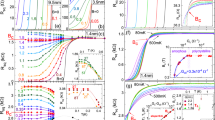Abstract
A strong disorder characterized by a small product of the Fermi vector kF and the electron mean free l drives superconductors towards insulating state. Such disorder can be introduced by making the films very thin. Here, we present 3-nm Mo2N film with kF*l ~ 2 with a resistive superconducting transition temperature Tc = 2 K heavily suppressed in comparison with the bulk Tc. Superconducting density of states (DOS) with smeared gap-like peaks and in-gap states, so called Dynes DOS, is observed by the low-temperature tunneling spectroscopy despite a sharp resistive transition. By scanning tunneling microscope, the spectral maps are obtained and related to the surface topography. The maps show a spatial variation of the superconducting energy gap on the order of 20% which is not accidental but well correlates with the surface corrugation: protrusions reveal larger gap, smaller spectral smearing, and smaller in-gap states. In agreement with our previous measurements on ultrathin MoC films, we suggest that the film-substrate interface introducing the local pair-breaking is responsible for the observed effects and generally for the suppression of the superconductivity in these ultrathin films.



Similar content being viewed by others
References
Finkel’stein, A.M.: Superconducting transition temperature in amorphous films. JETP Lett. 45, 46 (1987)
Fisher, M.P.A.: Quantum phase transitions in disordered two-dimensional superconductors. Phys. Rev. Lett. 65, 923–927 (1990). https://doi.org/10.1103/PhysRevLett.65.923
Sacépé, B., Chapelier, C., Baturina, T.I., Vinokur, V.M., Baklanov, M.R., Sanquer, M.: Disorder-Induced Inhomogeneities of the Superconducting State Close to the Superconductor-Insulator Transition. Phys. Rev. Lett. 101, 157006 (2008). https://doi.org/10.1103/PhysRevLett.101.157006
Hofer, J.A., Ginzburg, M., Bengio, S., Haberkorn, N.: Nanocrystalline superconducting γ-Mo2N ultra-thin films for single photon detectors. Mater Sci Eng B. 275, 115499 (2022). https://doi.org/10.1016/J.MSEB.2021.115499
Kuzmiak, M., et al.: to be published
Dynes, R.C., Narayanamurti, V., Garno, J.P.: Direct Measurement of Quasiparticle-Lifetime Broadening in a Strong-Coupled Superconductor. Phys. Rev. Lett. 41, 1509 (1978). https://doi.org/10.1103/PhysRevLett.41.1509
Hašková, V., Kopčík, M., Szabó, P., Samuely, T., Kačmarčík, J., Onufriienko, O., Žemlička, M., Neilinger, P., Grajcar, M., Samuely, P.: On the origin of in-gap states in homogeneously disordered ultrathin films. MoC case. Appl. Surf. Sci. 461, 143–148 (2018). https://doi.org/10.1016/J.APSUSC.2018.06.228
Kozejova, M., Latyshev, V., Kavecansky, V., You, H., Vorobiov, S., Kovalcikova, A., Komanicky, V.: Evaluation of hydrogen evolution reaction activity of molybdenum nitride thin films on their nitrogen content. Electrochim. Acta. 315, 9–16 (2019). https://doi.org/10.1016/J.ELECTACTA.2019.05.097
van der Pauw, L.J.: A method of measuring specific resistivity and Hall effect of discs of arbitrary shape. Philips Res. Rep. 13, 1–9 (1958)
Ioffe, A.F., Regel, A.R.: Non-crystalline, amorphous and liquid electronic semiconductors. Prog. Semicond. 4, 237–291 (1960)
Hamers, R.J., Tromp, R.M., Demuth, J.E.: Surface Electronic Structure of Si (111)-(7×7) Resolved in Real Space. Phys. Rev. Lett. 56, 1972 (1986). https://doi.org/10.1103/PhysRevLett.56.1972
Gantmakher, V.F., Dolgopolov, V.T.: Superconductor–insulator quantum phase transition. Phys.-Usp. 53, 1 (2010). https://doi.org/10.3367/UFNE.0180.201001A.0003
Altshuler, B.L., Aronov, A.G.: Electron-Electron Interaction In Disordered Conductors. 10, 1–153 (1985). https://doi.org/10.1016/B978-0-444-86916-6.50007-7
Szabó, P., Samuely, T., Hašková, V., Kačmarčík, J., Žemlička, M., Grajcar, M., Rodrigo, J.G., Samuely, P.: Fermionic scenario for the destruction of superconductivity in ultrathin MoC films evidenced by STM measurements. Phys. Rev. B. 93, 014505 (2016). https://doi.org/10.1103/PhysRevB.93.014505
Samuely, P., Szabó, P., Klein, T., Jansen, A.G.M., Marcus, J., Escribe-Filippini, C., Wyder, P.: Upper critical field in Ba1-xKxBiO3: Magnetotransport vs. magnetotunneling. EPL. 41, 207–212 (1998). https://doi.org/10.1209/EPL/I1998-00132-1
Herman, F., Hlubina, R.: Microscopic interpretation of the Dynes formula for the tunneling density of states. Phys. Rev. B. 94, 144508 (2016). https://doi.org/10.1103/PhysRevB.94.144508
Proslier, T., Zasadzinski, J.F., Cooley, L., Antoine, C., Moore, J., Norem, J., Pellin, M., Gray, K.E.: Tunneling study of cavity grade Nb: Possible magnetic scattering at the surface. Appl. Phys. Lett. 92, 212505 (2008). https://doi.org/10.1063/1.2913764
Sundaresan, A., Rao, C.N.R.: Implications and consequences of ferromagnetism universally exhibited by inorganic nanoparticles. Solid State Commun. 149, 1197–1200 (2009). https://doi.org/10.1016/J.SSC.2009.04.028
Li, Q., Xu, J., Liu, J., Du, H., Ye, B.: Rise and fall of ferromagnetism in O-irradiated Al2O3 single crystals. Int. J. Appl. Phys. 117, 233904 (2015). https://doi.org/10.1063/1.4922788
Tamir, I., Trahms, M., Gorniaczyk, F., von Oppen, F., Shahar, D., Franke, K.J.: Direct observation of intrinsic surface magnetic disorder in amorphous superconducting films. arXiv:2112.05430. (2021)
Acknowledgements
We gratefully acknowledge helpful conversations with M. Grajcar and R. Hlubina.
Funding
This work was supported by the projects APVV-18–0358, VEGA 2/0058/20, VEGA 1/0743/19 the European Microkelvin Platform, the COST action CA16218 (Nanocohybri), and by US Steel Košice.
Author information
Authors and Affiliations
Corresponding author
Additional information
Publisher's Note
Springer Nature remains neutral with regard to jurisdictional claims in published maps and institutional affiliations.
Rights and permissions
About this article
Cite this article
Kuzmiak, M., Kopčík, M., Košuth, F. et al. Suppressed Superconductivity in Ultrathin Mo2N Films due to Pair-Breaking at the Interface. J Supercond Nov Magn 35, 1775–1780 (2022). https://doi.org/10.1007/s10948-022-06197-6
Received:
Accepted:
Published:
Issue Date:
DOI: https://doi.org/10.1007/s10948-022-06197-6




